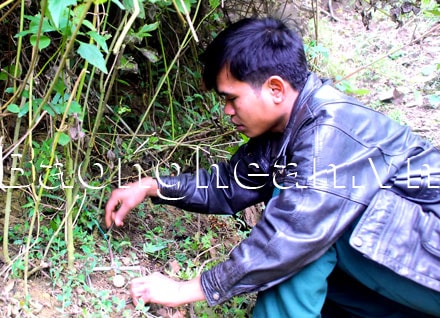"Hunting" wild rats with local boys in Bao Nam
(Baonghean.vn) -Bao Nam Commune, Ky Son District (Nghe An) is nestled among the vast green forests of the Truong Son Mountains. Under the forest canopy, the Khmu ethnic people hunt wild rats to make a unique dish.
In the afternoon, when the sunset disappears on the other side of Truong Son, the “rat hunters” with their tools divide up and head into the deep forest. On each trip, each “hunter” brings with them about fifty traps, which is equivalent to a certain amount of bait. After asking around the people in Nam Tien 1 village, Bao Nam commune, I was quickly introduced to Cut Van Ta – a “master” at “hunting” wild rats in the village. Cut Van Ta is 28 years old this year, of average height, dark skin, jet-black eyes, famous for having hunted the most wild rats in the village in 2010.
While sitting down to arrange and check the traps, Ta said: nowadays the village boys go "hunting" with iron traps bought outside Muong Xen town. Big traps cost 5 thousand each, small traps cost 3 thousand each. Every evening before leaving, they visit the traps the next morning. In the village, every house has at least a few dozen. The village boys compete to see who can "hunt" the most wild rats. Whoever is the champion is highly respected by the villagers!

The experience of an exceptional "hunter" told Cut Van Ta to set traps where wild rats were looking for food.
I asked about the secret that brought Ta to the championship position. He happily said: "There is no secret. I am just luckier than the other guys." Having said that, Ta also enthusiastically showed me a few "techniques" of "hunting" wild rats that any "hunter" must know before entering the profession: "If you want to catch a lot of wild rats, you need to understand their rules. First, you have to determine the path of the rats. Second, you have to know how to observe the tree roots, where there is soil rising, that means there are rats, you have to set traps in those places to intercept them." Saying that, Ta showed me how to set bait and traps. He said: "The rice harvest season and the chestnut season are the seasons when you can "hunt" the most rats, and the rats are also the fattest and tastiest. Because at this time, rats often sneak into the rice fields or chestnut trees to find food."
While sitting and talking with Ta, Cut Van Tuyen - Ta's older brother came to visit. Mr. Tuyen is a teacher at Bao Nam 1 Primary School. However, in his free time, he still brings traps into the forest to "hunt" mice. "I'm busy with government work so I don't have much time. Only when I have free time, I go into the forest to "hunt" mice. I'm not as good as Ta", Mr. Tuyen modestly said.
“Hunting” wild rats is a traditional “occupation” of the Khmu people in Bao Nam. Because no one knows when, dishes made from rat meat have been especially loved by the people. During holidays and Tet, wild rat meat is an indispensable part of the meal tray. The most famous of which is the dish “au mu chut”. Mr. Cut Hai Phuong – a village elder in Nam Tien 1 village said the recipe: “Au mu chut dish is made from rat meat, wild banana flowers, onions, garlic, sage leaves… All are put in a pot and cooked until the water is dry. This dish is often eaten with sticky rice. In addition, rat meat is also used to make a number of other dishes such as soup with vegetables…”.
Mr. Phuong was also a master at “hunting” wild rats. Since he was 10 years old, he followed his father into the forest to set traps. “Back then, there were no ready-made iron traps like today. To “hunt” rats, we had to make traps out of stones, which was very elaborate! We dug a hole and put the bait in it. On top, a stone supported by a small piece of firewood was waiting. When the rats fell into the hole to eat the bait, the firewood collapsed, and the stone collapsed, covering the hole,” he recalled.
Cut Van Ta said: “During the traditional New Year of the Khmu people, any family that “hunts” a lot of rats and prepares delicious “u muu rat” is very proud because they are praised by the village! Whoever “hunts” the most wild rats in the village will invite the villagers to their house to drink rice wine and eat rat meat. At that time, the champion “hunter” of the year is congratulated and praised by the villagers not only for his rat-hunting skills but also for helping the village’s rice fields to recover from the destruction.”
Although modern life has changed a lot, the Khmu people in Bao Nam still preserve this unique but rather strange custom.
Thanh Duy






